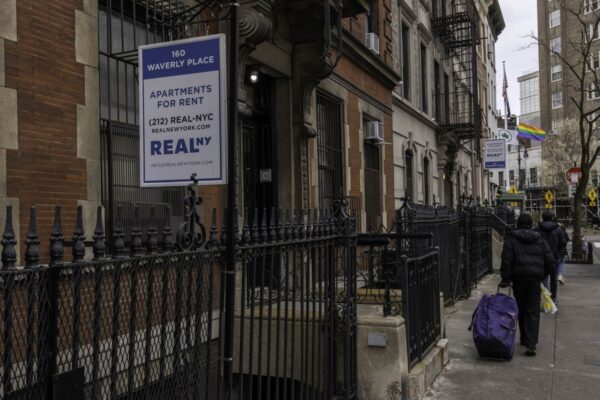By Patrick Clark and Prashant Gopal
US apartment landlords who benefited from rapid rent growth during the pandemic are suddenly in the red.

Higher interest rates and surging expenses are erasing their profits, even as rents are still climbing in many places. Debt payments already exceed income from multifamily buildings financed with more than $47 billion of securitized loans, according to data from Trepp.
Making matters worse, property taxes are escalating swiftly and the destructive path of climate change is sending insurance costs skyward. And building values are falling, complicating owners’ efforts to sell or refinance their way out of trouble.
“The problem is, nobody expected expenses to rise as much as they did,” said Jay Parsons, chief economist for RealPage, a rental-data tracker. “In particular, investors with floating-rate loans resetting at significantly higher rates could be challenged to cover debt payments.”
For now, the fallout has been limited. That’s because investors often purchase rate caps that protect them from the worst effects of soaring interest costs. But those policies are likely to begin burning off at a rapid rate later this year, leaving a growing number of owners vulnerable.
Higher costs are weighing on a broad range of industry players, from private equity giants to crowdfunding firms, old hands and upstart players, Sun Belt specialists and urban operators. Even landlords in the biggest and most expensive rental market in the country — New York City — aren’t immune.
Take A&E Real Estate, one of New York’s biggest landlords. The firm refinanced a portfolio of 3,500 mostly rent-stabilized apartments in June 2021, when the Federal Reserve’s efforts to soften the economic blow from Covid drove borrowing costs to historic lows.
A&E’s rate cap limits interest on the $506 million loan at 3.66% — roughly half of what the firm would pay without the policy. The landlord will have to buy a new rate cap when the loan matures in June 2024, raising “concerns regarding the asset’s ability to cover future debt service,” according to a recent report by KBRA Analytics.
KBRA’s analysis underestimates occupancies, rent growth and valuations for A&E’s buildings, many of which are in desirable outer-boroughs neighborhoods, according to Bud Perrone, a spokesman for the landlord.
“We have remained current on payments since the inception of our loan and have zero concerns about meeting all future obligations to our lenders,” Perrone said.
Defaults Looming
Still, the situation hints at a deeper problem for the multifamily industry. During the pandemic boom, lenders were eager to make highly leveraged bridge loans to buyers rushing to scoop up apartments. The short-term, floating-rate financing paid for the acquisition as well as renovations that would enable landlords to raise rents, in turn providing more cushion to service debt.
Now, interest costs are overtaking their profits, potentially leading to a “great deleveraging,” in which owners will have to pony up fresh capital or walk away from their holdings, according to Ben Miller, chief executive officer of real estate firm Fundrise.
“The market needs to recognize that there’s a huge amount of debt outstanding that’s going to go into default,” Miller said.
In one early example, Applesway Investment Group, a Houston-based apartment syndicator led by Jay Gajavelli, defaulted on $230 million of floating-rate loans, sending 3,200 units into foreclosure in April. An insitutional investor who was already part of the deal recapitalized the portfolio, and lender Arbor Realty Trust restructured the debt.
“Arbor took no loss on the transaction and we are very comfortable with this investor,” Chief Executive Officer Ivan Kaufman said in an email.
Applesway didn’t respond to a request for comment.
Asset values are still well above pre-pandemic levels and landlords who avoided riskier loans aren’t facing short-term distress. But owners looking for a quick exit are in a bind.
Prices have fallen by an estimated 15% to 20% since the Fed began raising interest rates last March, said Aaron Jodka, research director for US capital markets at Colliers.
“Buyers are seeking price reductions,” Jodka said. “Cost of debt is up, meaning I can’t pay 2021 prices.”
Pricey Insurance
It’s already gotten harder to make a profit in markets that were hottest with investors during the buying boom. That’s partly because migration to those places has slowed, and an influx of brand-new units is hurting landlords’ pricing power. It’s also due to rising costs for property taxes and insurance.
For owners that renewed policies this year, costs jumped at least 30%, often doubling or tripling in coastal areas of Florida and Texas, said Danielle Lombardo, chair of the global real estate practice for Lockton Companies, a large insurance broker. At one building with more than 700 units in Corpus Christie, Texas, the yearly premium jumped to $3.7 million, up from $1 million, she said.
With weather events that are unusual and more severe, underwriters are increasing rates, reducing coverage and raising deductibles, Lombardo said.
“We’re in the worst insurance market in history,” she said. “It’s the constant conversation: ‘If I have to buy the full limits, I can’t pay the debt service.’ It’s a wildly difficult time in multifamily unless you’re cash rich, which many of these guys are not.”
More stories like this are available on bloomberg.com




